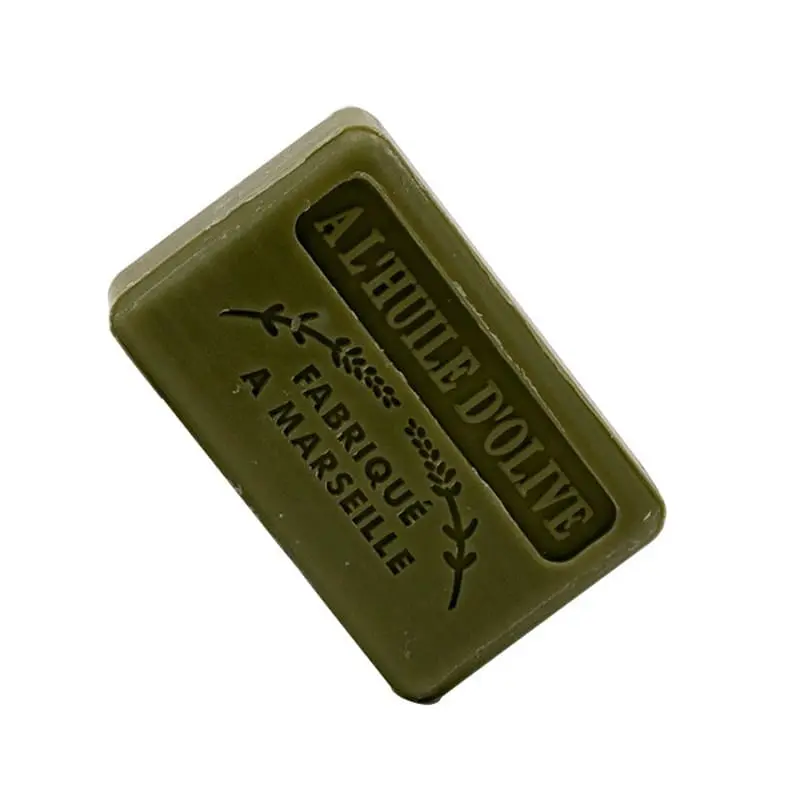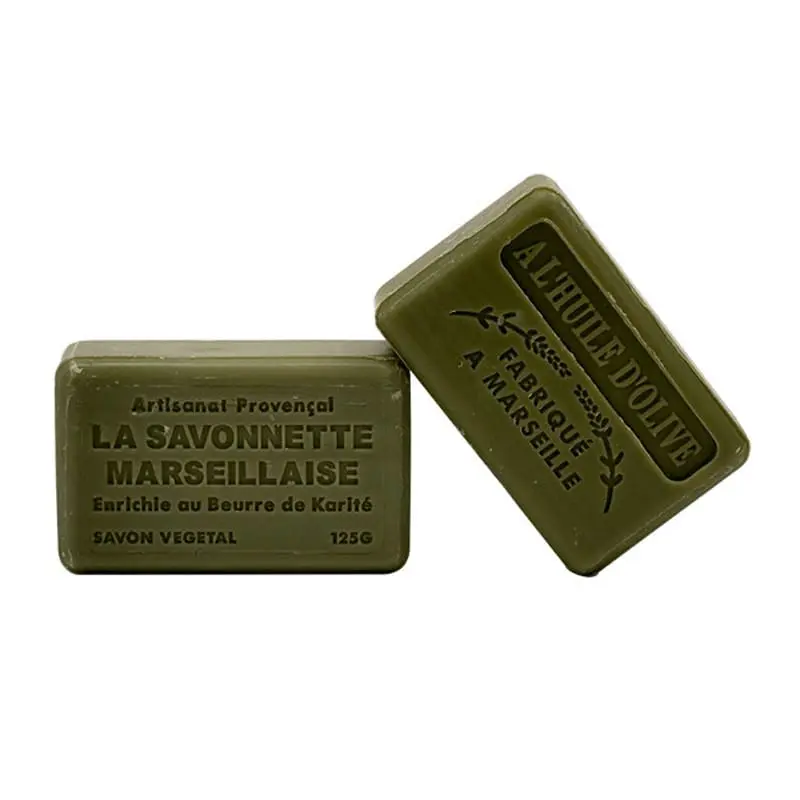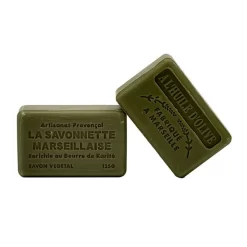Aceite de Oliva
4,75€
Jabón natural com azeite, poderosas propriedades nutritivas, revitalizantes e antioxidantes. Ajuda a retardar os sinais de envolvimento cutâneo devido ao seu elevado teor de vitamina E.
É um jabão suave, protege a pele, proporciona brilho, frescura e elasticidade.
É um excelente nutriente, funciona como agente anti-envelhecimento e proporciona à pele brilhante uma textura suave e elástica.
No óleo de oliva encontram-se diversas substâncias antioxidantes: os flavonóides, os polifenóis e a vitamina E, que é o que leva ao óleo a propriedade de conservar; e al ser um antioxidante celular, retardando o envolvimento das células.
O azeite virgem extra tem um perfil lipídico muito semelhante ao da pele do ser humano, protege a pele face a fatores ambientais externos, hidrata e mantém a estrutura íntegra da derme, permitindo uma melhor regeneração.
É muito eficaz para o cabelo devolvendo-lhe força, brilho e hidratando profundamente o couro cabeludo.
Ao longo da história, o uso do azeite para o cuidado da pele foi venerado por todas as civilizações que o conheceram.
Tomate: 125gr
História do Olivo e do seu óleo
O Olivo, símbolo da sabedoria e da paz, foi adotado pela raça humana como fonte de riqueza e alimento desde há milénios. A história de Olivo remonta à origem da agricultura nas primeiras civilizações do Mediterrâneo e do Próximo Oriente.
Pré-história
A existência do olival remonta a 12.000 anos a.C. Foram encontrados fósseis de folhas de azeitona em depósitos do plioceno de Mongardino, Itália, bem como em estratos rochosos do período Paleolítico Superior no Norte de África e em escavações da era do bronze em Espanha.
Egito
O início do cultivo do azeite situava-se no oriente médio e próximo, e as primeiras referências documentais e arqueológicas sobre a aparência e uso do azeite de oliva eram provenientes da época do Antigo Egito, onde era venerado e estava apenas no alcance das classes privilegiadas.
No Egipto o olival aparece representado nos sarcófagos de alguns faraós. O azeite era preparado com essências aromáticas e era utilizado como óleo sacramental dos Faraones no máximo.
Segundo a mitologia egípcia, foi Ísis quem ensinou aos homens o cultivo do azeite. As maiores plantações de azeite estão localizadas perto do delta do Nilo, muito perto da cidade de Alexandria. Por exemplo, fala-se do azeite no Fayum e no Tebaida.
A variedade de azeites empregada no Egipto não teria um grande rendimento em óleo, pois o clima seria pouco propício ao seu crescimento e desenvolvimento; por esta razão, o uso do azeite como alimento era escasso e era utilizado principalmente para aplicações medicinais e cosméticas.
El Papiro Harris menciona diversas fontes de azeite, e um importante comércio deste com as tribos gregas. O uso de azeite nas lâmpadas funerárias era comum, e Ramsés III destinou plantações à sua produção.
A palavra óleo não aparece nos textos até cerca da novena dinastia do Egito.
Nas populações escravas de religião judaica egípcia, o azeite cobrava um simbolismo especial. Foi adicionado a bebidas como o khilmi e o alontit, e até mesmo ao vinho anigron.
Juntamente com outras essências e ervas aromáticas, foi utilizado no fabrico de perfumes embebidos, no banho para embelezar e limpar os poros, em unguentos com azafrán e ervas para hidratar a pele e evitar o aparecimento de rugas, para abrilhantar o cabelo e para massagens terapêuticas.
Tinha profundas conotações espirituais e era utilizada nas lâmpadas acesas em honra dos deuses.
Grécia
A mitologia grega é rica em lendas e menções a Olivo, Deus como Atenea, Hércules, ou os jogos Olímpicos têm como elemento característico o Olivo, as suas ramagens, folhas e fruto. As primeiras referências documentadas sobre o Olivo eram griegas: simbolizavam a paz e a prosperidade, tal como a ressurreição e a esperança.
Nos primeiros jogos olímpicos celebrados em 776 a.C., foi oferecida aos vencedores das provas desportivas uma ramita de azeitona como reconhecimento do seu triunfo, e a primeira torre olímpica foi uma ramita de azeitona em chamas. As ginásticas, antes do exercício, devem ser feitas massagens para colocar os músculos em ponto, evitar lesões e proteger a pele das diferenças de temperatura.
Nas festas panatenaicas, semelhantes em importância aos jogos olímpicos, eram oferecidas aos vencedores ânforas de azeite. A quantidade de óleo oferecido como prémio ao vencedor de um prémio desportivo poderia ser grande, incluindo várias toneladas.
O aparecimento do azeite na Grécia ocorre na ilha de Creta, o seu cultivo leva ao estabelecimento das primeiras rotas comerciais ao longo do largo mar mediterrânico com o Egipto e outros povos.
As classes sociais mais baixas não consomem o azeite na cozinha ficando reservado para as classes mais favoritas. O uso como combustível para iluminação, como remédio medicinal e como óleo corporal era muito habitual.
Dioscórides menciona o onfacino, um óleo extraído da aceituna não madura, indicando que é útil para o stress muscular, o cuidado da pele e do cabelo. Hipócrates também menciona as suas propriedades medicinais.
No século V a. C. o rei persa Jerjes incendiou a cidade de Atenas, no interior da qual se deitou o azeite centenário de Atenea, que ficou calcinado. Quando os atletas entram na cidade arrasada, o azeite já criou um código, presságio da rápida recuperação e renovação dos atletas antes da adversidade.
O azeite aparece numas pequenas tábuas de barro, o que dá testemunho da importância do azeite na economia cretense (2500 a.C.).
A adoração dos gregos pelo azeite é mostrada nos frescos das muralhas do palácio de Cnossos, onde aparecem inúmeras representações de azeitonas.
Com frequência pode ver azeitonas nas decorações dos vasos, nas alegrias e nos restantes utensílios da vida quotidiana da época.
As unções já aparecem com frequência em Homero e dão-nas às mulheres e aos irmãos. Ulises diz a Nausicaa (Od. VI 96) «Sabei sem querer ajudar-me a lavar-me com espuma e a ungir-me com este óleo que passado tanto tempo a minha pele não conhece».
Cada pessoa levava aos banhos o seu frasco de óleo (lecythus).
O óleo serve de base para elaborar perfumes (Myron), embora o seu aroma fosse considerado por muitos como um perfume. A arqueologia (quadros microscópicos), as pinturas murais de Pompeia e os textos de Dioscórides, Teofrasto e Plínio mencionam esta utilização.
Considerava-se o melhor excipiente para elaborar um perfume, especialmente o ácido de azeitonas verdes que revestia pouco óleo, por ser receptivo, conservava bem e resistia ao calor.
Os antigos gregos são humedecidos com água e uma esponja, sem óleo (só a partir do século I a. C. é coberta com óleo uma fina camada de emulsão jabonosa), e ao sair do banho são untados com óleo.
Fenícios
Em Espanha, o cultivo do azeite foi introduzido pelos Fenícios (1100 a. C.).
Roma
A partir do ano 206 a. C, após a ocupação romana na Hispânia, a produção de olival começou a ganhar importância.
O contacto comercial e o guerreiro dos gregos com os etruscos fizeram com que o cultivo do azeite fosse introduzido em Itália durante o reinado de Lucio Tarquinio Prisco, no período 616 a.C. C. a 578 a. C., ainda podia ter chegado a Itália três anos antes da queda de Tróia.
Nos séculos II e III o olival expandiu-se pelo Mediterrâneo, graças aos avanços territoriais e militares do Império Romano. As coroas de azeitona servem de oferta aos generais romanos vitoriosos, tal como fizeram os gregos.
O uso do azeite foi muito difundido entre os habitantes da cidade de Roma, e a produção de azeite gerou uma paisagem agrícola nas colónias romanas.
Plinio el Viejo recolhe receitas de unguentos e pomadas com azeite.
Catón el Viejo descreve no seu livro Sobre a agricultura vários métodos de cultivo, poda e cuidado com o azeite, que aprenderam dos gregos.
A aplicação do primeiro creme hidratante deveu-se ao médico turco Claudio Galeno (129-199 d.C.), que descobriu que misturando azeite com água e cera de abelha se obtinha um creme hidratante que conferia grande elasticidade à pele.
Idade dos media
Depois da Decadência do Império Romano, são as ordens religiosas que começam a tomar as riendas da produção na Europa Medieval. O consumo entre os clérigos que vivem em mosteiros e as pessoas da classe alta manteve-se sempre.
Utilizado na cozinha, na iluminação de casas, na elaboração de painéis e tecidos, aplicações para as quais era muito útil e difícil de recolocar.
Bíblia
Na Bíblia, encontram-se algumas menções quadruplicadas ao olival ou ao óleo. Era a base do bálsamo da unção e da luz que iluminava as trevas dos templos e dos lares. No Livro do Génesis, uma palmeira entregou um ramo de oliveira a Noé, anunciando o fim do diluvio e das inundações. Noé reconheceu este gesto como um sinal da paz que se venderia. No Livro do Êxodo, Deus disse a Moisés como preparar um azeite e especiarias para ungir a sua cidade; menciona também a oração de Jesucristo no Monte dos Olivos.
Em Al-Andalus a produção de azeite era muito intensa e tinha zonas, como o Aljarafe perto de Sevilha, onde estavam cheias de azeitonas. O escritor muçulmano da época Al-Idrisi refere que a riqueza dos habitantes de Sevilha se deve em grande parte à exportação de azeite.





